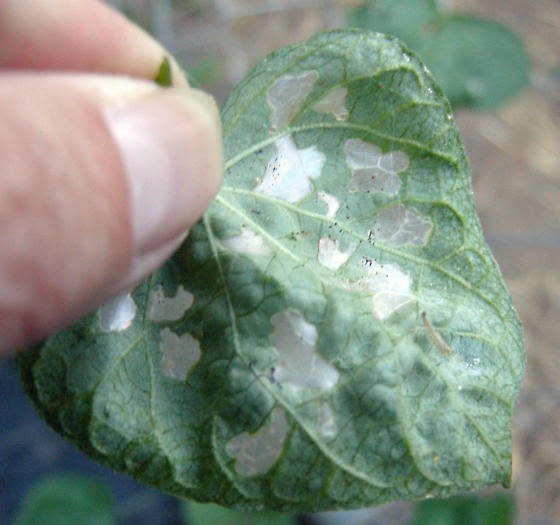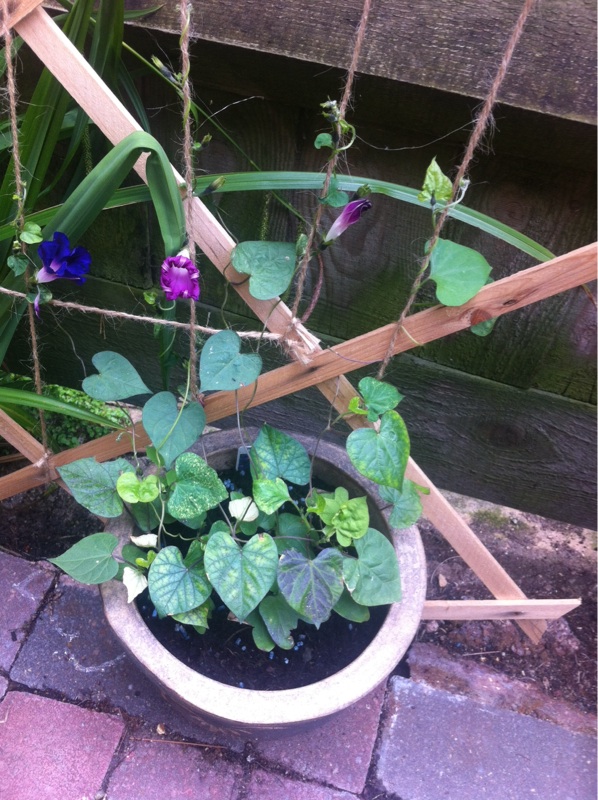Morning Glory leaves can face several problems, including pest infestations, fungal diseases, and nutrient deficiencies. Identifying these issues early helps ensure healthy plant growth.
Morning Glory plants are beloved for their vibrant blooms and quick growth. Yet, they are not immune to various challenges that can affect their leaves. Common problems include pests like aphids and spider mites, which can sap the plant’s vitality.
Fungal infections, such as powdery mildew, can also take a toll. Nutrient deficiencies, particularly in nitrogen or potassium, may lead to yellowing leaves or stunted growth. Understanding these issues is crucial for gardeners who want to maintain healthy Morning Glory plants. Timely intervention can make a significant difference in preserving their beauty and vigor.
Identifying Common Morning Glory Leaf Issues
Morning glory plants can face various leaf problems. Recognizing these issues early helps keep your plants healthy. This section covers key signs to watch for.
Signs Of Nutrient Deficiencies
Nutrient deficiencies can cause several problems in morning glory leaves. Here are common signs:
- Yellowing Leaves: Indicates a lack of nitrogen.
- Brown Tips: May show potassium deficiency.
- Stunted Growth: Often a sign of phosphorus shortage.
- Leaf Curling: Can indicate magnesium deficiency.
| Nutrient | Signs |
|---|---|
| Nitrogen | Yellowing leaves |
| Potassium | Brown tips |
| Phosphorus | Stunted growth |
| Magnesium | Leaf curling |
Check soil regularly. Use a balanced fertilizer to correct deficiencies.
Pest Infestation Markers
Pests can seriously harm morning glory leaves. Look for these signs:
- Holes in Leaves: Often caused by caterpillars or beetles.
- Webbing: Indicates spider mites are present.
- Sticky Residue: This can be a sign of aphids.
- Discolored Spots: May indicate fungal infections or pest damage.
Inspect leaves regularly. Remove pests by hand or use insecticidal soap. Keeping plants healthy prevents infestations.
Addressing Yellowing Leaves
Yellowing leaves on your Morning Glory can be alarming. This issue often signals underlying problems. Identifying the cause is key to restoring health.
Improving Soil Nutrition
Soil nutrition plays a major role in plant health. Lack of essential nutrients can lead to yellow leaves. Here are some important nutrients:
| Nutrient | Function | Sources |
|---|---|---|
| Nitrogen | Promotes leaf growth. | Compost, blood meal. |
| Iron | Helps with chlorophyll production. | Iron chelates, organic fertilizers. |
| Magnesium | Supports photosynthesis. | Epsom salts, dolomite lime. |
Test your soil regularly. Use a soil test kit. Adjust nutrient levels as needed. Adding compost can enhance soil quality.
Adjusting Watering Habits
Watering is crucial for plant health. Overwatering can cause root rot. Underwatering leads to stress and yellowing leaves.
- Check soil moisture weekly.
- Water deeply but less frequently.
- Ensure pots have drainage holes.
Signs of overwatering include:
- Soggy soil.
- Wilting leaves.
- Blackened roots.
Signs of underwatering include:
- Crispy edges on leaves.
- Dry soil.
- Leaf drop.
Combatting Leaf Spots
Morning Glory plants often face leaf spot issues. These spots can affect their health and beauty. Understanding their causes and solutions is essential for healthy growth.
Fungal Infections And Treatments
Fungal infections are common culprits for leaf spots. They thrive in warm, humid conditions. Here are some signs and treatments:
| Signs of Fungal Infections | Treatments |
|---|---|
| Brown or black spots on leaves | Apply a fungicide spray. |
| Yellowing leaves | Remove affected leaves promptly. |
| Wilting or drooping | Ensure proper air circulation. |
Choose a fungicide that targets specific fungi. Always read the instructions. Regularly check your plants for early signs of infection.
Environmental Factors And Prevention
Environmental factors play a big role in leaf spots. Here are some key aspects to consider:
- Watering practices: Water early in the day to reduce humidity.
- Soil drainage: Ensure good drainage to prevent waterlogging.
- Sunlight exposure: Provide enough sunlight for healthy growth.
- Inspect plants weekly for leaf spots.
- Adjust watering based on weather conditions.
- Rotate crops to prevent fungal buildup.
Keep the garden clean by removing dead leaves. This reduces fungal spores in the air. Healthy Morning Glory plants are less susceptible to leaf spots.
Dealing With Curling And Wilting
Curling and wilting of Morning Glory leaves can signal problems. These issues can stem from various factors. Early detection is key to maintaining healthy plants.
Root Health Check
Root health is crucial for Morning Glory plants. Check roots regularly for signs of distress.
- Look for discoloration. Healthy roots are white or light tan.
- Check for mushy or rotten roots. This can indicate overwatering.
- Inspect for pests like root aphids. They can damage roots.
Use the following steps for a root health check:
- Gently remove the plant from its pot.
- Examine the roots closely.
- Trim any damaged roots with clean scissors.
- Replant in fresh, well-draining soil.
Heat Stress And Mitigation Strategies
High temperatures can lead to heat stress in Morning Glory. Signs include curling and wilting leaves. Protect your plants with these strategies:
| Strategy | Description |
|---|---|
| Shade | Provide shade during peak sunlight hours. |
| Watering | Water in the early morning or late evening. |
| Mulching | Apply mulch to retain soil moisture. |
| Ventilation | Ensure good air circulation around plants. |
Monitor your plants closely. Adjust care routines as needed. This will help keep your Morning Glory thriving.
Managing Pests On Morning Glories
Morning glories are beautiful but can attract pests. Managing these pests is essential for plant health. Effective pest control keeps your morning glories thriving.
Natural Predators And Biological Control
Using natural predators is a safe way to manage pests. These beneficial insects help control harmful pest populations.
- Ladybugs: They eat aphids and mites.
- Lacewings: Their larvae consume various pests.
- Parasitic wasps: They target caterpillars and other pests.
Encouraging these predators can create a balanced ecosystem in your garden. Plant flowers like marigolds and yarrow to attract them.
Organic Pesticides And Application Tips
Organic pesticides are effective and safe for the environment. They control pests without harming beneficial insects.
| Pesticide | Target Pest | Application Method |
|---|---|---|
| Neem Oil | Aphids, spider mites | Spray directly on affected areas |
| Insecticidal Soap | Soft-bodied insects | Apply in the early morning or late evening |
| Garlic Spray | Various pests | Spray on leaves and stems |
Follow these tips for effective application:
- Apply during cool parts of the day.
- Ensure thorough coverage on leaves.
- Reapply after rain or watering.
Monitor your plants regularly. Early detection prevents larger infestations.

Credit: bugguide.net
Preventing Common Diseases
Healthy Morning Glory plants require proper care. Preventing diseases keeps your garden vibrant. Focus on effective strategies to protect your plants.
Rotation And Plant Hygiene Practices
Rotating your crops helps prevent disease buildup. Follow these simple practices:
- Change planting locations each season.
- Avoid planting Morning Glory in the same spot for two years.
- Clear away plant debris after harvest.
- Use clean tools to reduce disease spread.
Implementing good hygiene practices protects your plants from pathogens. Cleanliness is key to maintaining plant health.
Resistant Varieties And Their Advantages
Choosing resistant varieties can save your plants. Here are some benefits:
| Advantages | Description |
|---|---|
| Reduced Risk | Lower chance of disease affecting your plants. |
| Less Maintenance | Fewer treatments needed for pests and diseases. |
| Better Yields | Healthier plants produce more flowers and leaves. |
Research resistant varieties for your area. They can offer better protection and easier care.
Nurturing Healthy Growth
Nurturing healthy growth for your Morning Glory plants is essential. Proper care prevents common leaf problems. This section covers optimal sunlight exposure and essential pruning techniques.
Optimal Sunlight Exposure
Morning Glory plants thrive in bright, direct sunlight. Aim for at least 6 hours of sun each day. Here’s a quick guide:
| Sunlight Condition | Effect on Growth |
|---|---|
| Full Sun | Promotes vibrant blooms and lush foliage. |
| Partial Shade | May result in sparse growth and fewer flowers. |
| Full Shade | Causes leggy growth and weak plants. |
Monitor your plants daily. Check for signs of stress. Adjust their location if necessary. Here are some tips for optimal sunlight:
- Place pots in sunny spots.
- Rotate pots weekly for even light.
- Protect from harsh afternoon sun.
Essential Pruning Techniques
Pruning helps maintain plant health and promotes growth. Follow these easy steps:
- Use clean, sharp scissors.
- Remove dead or yellowing leaves.
- Trim back overgrown vines.
- Encourage bushier growth by pinching tips.
Pruning should occur regularly. This keeps your plants healthy and vibrant. Keep an eye on growth patterns. Adjust pruning frequency based on plant needs.
Healthy Morning Glory plants bring joy. Focus on sunlight and pruning for best results.
Eco-friendly Tips For Leaf Care
Caring for your Morning Glory leaves can be simple and eco-friendly. Using natural methods helps plants thrive. These tips promote healthy growth while protecting the environment.
Homemade Remedies For Leaf Problems
Homemade remedies can effectively address common leaf issues. Here are some easy solutions:
- Neem Oil: Mix neem oil with water. Spray on leaves to fight pests.
- Soap Spray: Combine mild soap with water. Use this mixture to wash off aphids.
- Coffee Grounds: Sprinkle used coffee grounds around the base. This adds nutrients and deters pests.
- Garlic Spray: Blend garlic with water. Strain and spray to repel harmful insects.
Sustainable Watering Practices
Watering correctly saves resources and helps your plants. Follow these sustainable practices:
- Use Rainwater: Collect rainwater in barrels. This is free and nutrient-rich.
- Water Early: Water in the morning. This reduces evaporation.
- Drip Irrigation: Install a drip system. This delivers water directly to the roots.
- Mulching: Add a layer of mulch. It retains moisture and prevents weeds.
These eco-friendly tips enhance your Morning Glory’s health. Enjoy a vibrant garden with minimal environmental impact.
Monitoring And Maintenance Routine
Maintaining healthy Morning Glory leaves requires a consistent monitoring routine. Regular checks help spot issues early. This routine ensures your plants thrive and produce beautiful blooms. Establishing a systematic approach makes a big difference.
Regular Observation Schedule
Set a regular observation schedule to monitor your Morning Glory leaves. Here are some tips to follow:
- Check plants every 3-5 days.
- Look for signs of pests or disease.
- Observe leaf color and texture.
- Inspect the soil moisture levels.
Use the following table to track your observations:
| Date | Observations | Actions Taken |
|---|---|---|
| MM/DD/YYYY | Healthy leaves, no pests | No action needed |
| MM/DD/YYYY | Yellowing leaves | Check soil moisture |
Record Keeping For Plant Health
Maintain a record-keeping system for your Morning Glory plants. Documentation helps track changes over time. This can guide your maintenance decisions. Here are some essential records to keep:
- Date of each observation.
- Notes on leaf conditions.
- Pest sightings and treatments.
- Watering schedule and soil conditions.
Consider using a notebook or a digital app. Regular entries will keep your plants healthy. This practice leads to better gardening results.
Credit: www.gardenstew.com
Troubleshooting Advanced Issues
Troubleshooting advanced issues with Morning Glory leaves can be challenging. Understanding the signs can help you act quickly. This section covers when to seek help and advanced diagnostic tools.
When To Seek Professional Help
Some issues require expert intervention. Watch for these signs:
- Severe discoloration on multiple leaves.
- Wilting that doesn’t improve with watering.
- Unusual pests that you can’t identify.
- Fungal growth spreading rapidly.
Contact a professional if:
- You notice multiple plants affected.
- Common remedies fail to work.
- The problem worsens over time.
Advanced Diagnostic Tools
Using the right tools can help diagnose issues effectively. Here are some advanced tools:
| Tool | Purpose |
|---|---|
| Soil pH Meter | Measures soil acidity and alkalinity. |
| Moisture Meter | Checks soil moisture levels. |
| Magnifying Glass | Helps identify small pests. |
| Fungicide Test Kits | Tests for fungal infections. |
Use these tools to gather data about your plants. This will help in making informed decisions.

Credit: www.gardenanswers.com
Frequently Asked Questions
What Are Common Issues With Morning Glory Leaves?
Common issues include yellowing, wilting, and pests like aphids, which can affect overall plant health.
How Do I Fix Yellowing Morning Glory Leaves?
Yellowing leaves often indicate overwatering or nutrient deficiencies. Adjust watering and consider fertilizing with a balanced nutrient mix.
Why Are My Morning Glory Leaves Curling?
Leaf curling can result from environmental stress, such as extreme temperatures or pest infestations. Check for pests and adjust conditions.
What Pests Affect Morning Glory Plants?
Common pests include aphids, spider mites, and whiteflies. Regular inspection and pest control measures can help keep them at bay.
How Can I Prevent Morning Glory Leaf Problems?
Maintain proper watering, ensure good soil drainage, and regularly inspect for pests to prevent common leaf issues.
Conclusion
Addressing Morning Glory leaf problems is essential for a thriving garden. Regular inspection and proper care can prevent many issues. Use organic solutions whenever possible to maintain plant health. By staying informed and proactive, you can enjoy vibrant Morning Glory plants.
A healthy garden enhances your outdoor space and brings joy.
